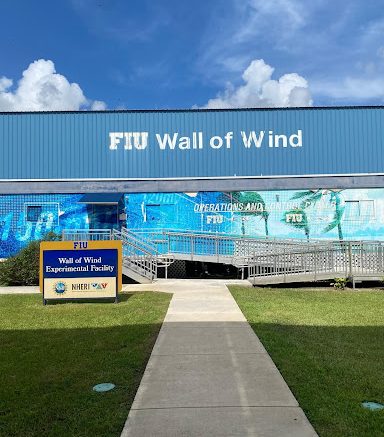Magali Zoghaib | Staff Writer
Was the recent catastrophic flooding in south Florida a precursor to an intense hurricane season?
The National Oceanic and Atmospheric Association predicts an 85% chance of an “above normal season” in the Atlantic Basin thanks to near record high ocean temperatures.
For a hurricane to develop, one of the conditions is that ocean water temperature must be above 79 degrees fahrenheit (26 degrees celsius) and the ocean temperature in the tropical east pacific and the tropical atlantic are constantly surpassing that threshold, according to the National Weather Service.
Estimated by the NOAA with a 70% confidence rate, a range of 17 to 25 total named storms (39 mph or higher wind speed) and 8 to 13 of which are expected to become hurricanes (74 mph or higher wind speed), including 4 to 7 major hurricanes (categories 3, 4, or 5 with 111 mph or higher wind speeds).
| A summary infographic displaying the probability and predicted number of named storms for the 2024 Atlantic Hurricane Season, based on NOAA’s outlook.(image credit: NOAA) | A summary graphic presenting an alphabetical list of the 2024 Atlantic tropical cyclone names chosen by the World Meteorological Organization. (image credit: NOAA) |
| NOAA Hurricane Tracker: Major Hurricanes Since 2017 and Their Impacted Areas | Forecasted Hotspots for the Current Hurricane Season: WESH Prediction |
According to the National Hazards Center, during Hurricane Andrew, one- and two-story wood-frame residential buildings experienced catastrophic failures more frequently than other types of buildings. This is largely due to the lack of engineering oversight in their design and construction, making residential structures particularly vulnerable to hurricane damage.
Considering the relatively small size of Andrew and its trajectory, which, like Hurricane Hugo, did not directly impact a major urban area, a key question that arose was whether the damage was proportionate to the storm’s intensity.
Are housing damages expected to be as severe as in previous years, and what measures are being taken to address this issue?
The NHERI Wall of Wind Experimental Facility at Florida International University is making history with its groundbreaking findings. Experimental research conducted at FIU’s Engineering Center aims to enhance understanding of how buildings can be better constructed to withstand the world’s most extreme conditions.
The Wall of Wind, a NSF-funded research center, features a powerful 12-fan system that can conduct repeatable tests with wind speeds reaching up to 157 mph.
12 Electric Fans in an Arc-Focal Arrangement | Magali Zoghaib, PantherNOW
This system, along with its advanced flow management capabilities, allows for detailed simulations of wind and wind-driven rain effects at multiple scales, ranging from full-scale to approximately 1:50, with high Reynolds numbers.
The Wall of Wind uses 3D-printed nozzles to simulate wind-driven rain, replicating hurricane raindrop sizes.
Water intrusion, a major cause of damage during and after hurricanes, leads to mold, electrical appliance damage, and structural issues.
Moreover, tests have identified key roof areas prone to water accumulation and intrusion, and the effectiveness of hurricane shutters in reducing water intrusion has also been assessed.
Additionally, the facility boasts a 16,000 square foot secure area dedicated to conducting destructive tests simulating wind speeds up to those of a Category 5 hurricane.
Turntable Capacity of 105,000lb (47.6 tons) static / 52,000lb (23.6 tons) dynamic | Magali Zoghaib, PantherNOW
The tests are performed with the help of a variety of advanced tools, instruments, and experimental protocols as well as the support of distinguished faculty, skilled staff, and a well-trained technical and operations team.
FANUC R-2000iB 165F used for handling very heavy objects and performing tasks across a large workspace | Magali Zoghaib, PantherNOW
One of the latest discoveries published in the NHERI Wall of Wind official website examines how roof shape affects the wind vulnerability of roof sheathing panels in low-rise residential structures.
This study by Hrishikesh Dev Sarma, Ioannis Zisis, and Manuel Matus uses Monte Carlo simulations and wind tunnel tests to compare the vulnerability of sheathing on roofs with various shapes (L-shaped, T-shaped, C-shaped, and rectangular).
The findings reveal significant differences in vulnerability between non-rectangular and rectangular roofs, highlighting critical wind directions and vulnerable areas for sheathing damage.
Research at the Wall of Wind is consistently active and ongoing, aiming to enhance the resilience of our built environment against extreme wind events.
Some notable studies include research on solar panels, which revealed that contrary to previous beliefs, panel vibrations actually increase wind loads on these panels.
Additionally, research on irregularly shaped buildings demonstrated that wind loads are higher on the walls and corners compared to regular buildings.
Furthermore, studies on elevated houses showed that their floors are susceptible to wind-induced damage.
All these findings are being prepared for submission to the American Society of Civil Engineers building code, set to be published in 2028.
Houssam Al Sayegh, a doctoral candidate and research assistant at the NHERI Wall of Wind, is currently investigating the performance of ballasted photovoltaic arrays under extreme wind conditions.
These ballasted solar systems, which rely on their weight to resist uplift forces rather than being physically anchored to the roof, are crucial for providing electrical power to commercial buildings and facilities, especially during hurricanes when the power grid may fail.
His research aims to enhance the design of these systems to prevent wind-induced failures, ensuring their resilience and reliability.
“One of the things that distinguishes the WOW is its ability to perform full- and large-scale destructive testing”, said Houssam in an interview with PantherNOW. “These tests allow for the visualization of the failure modes of various building components under real time simulated hurricane winds”.
The Wall of Wind experimental facility continuously collaborates with Florida authorities, particularly the Department of Emergency Management, which provides annual funding to enhance knowledge and improve the resilience of the state’s housing and infrastructure.
Additionally, the Department of Transportation and Florida Power & Light regularly use the Wall of Wind’s capabilities to test the resilience of their installations, such as light poles and traffic lights.
“These collaborations emphasize the role of the state of Florida in funding wind hazard research to further improve and enhance community resilience”, said Houssam.
Unfortunately, some current houses are built in high-risk hurricane zones or were not constructed to withstand hurricanes, making them vulnerable to severe damages.
Therefore, individuals must take precautions and steps to stay safe especially during this hurricane season, which is predicted to be greater than usual.
“Severe weather and emergencies can happen at any moment, which is why individuals and communities need to be prepared today,” said FEMA Deputy Administrator Erik A. Hooks to the NOAA. “Already, we are seeing storms move across the country that can bring additional hazards like tornadoes, flooding and hail. Taking a proactive approach to our increasingly challenging climate landscape today can make a difference in how people can recover tomorrow.”
On-campus housing residents at FIU who opt for on-campus hurricane shelter will be able to seek refuge in the Parkview hallways. It is important to note that the student housing facilities on the Modesto A. Maidique Campus are equipped with hurricane screens.
For more information on how to prepare for a hurricane, check out FIU’s Guide to Hurricane Preparedness and read our latest article on How to prepare for this year’s hurricane season.






Be the first to comment on "The 2024 Hurricane Season is On: Will History Repeat Itself?"